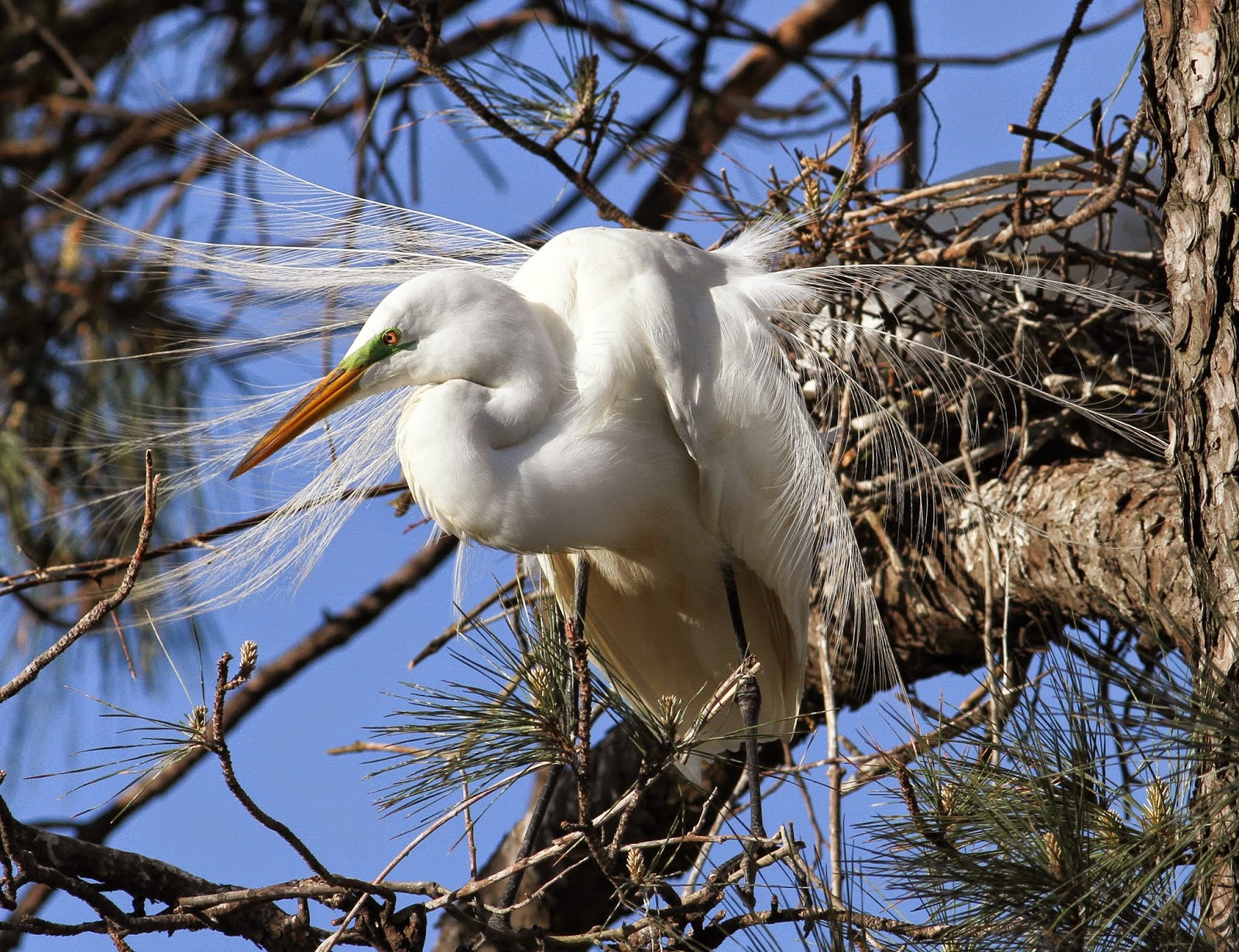Springtime is a very active time of year for birds and bird
watchers. Most of the winter birds and waterfowl have left Hampton Roads to
head north to their breeding grounds, but there are new arrivals every day of
birds that spent their winter south of us and are returning north to their
breeding grounds. Some stay in Virginia to breed, like the industrious little Barn Swallow, above, that is collecting mud and sticks for its nest, and some species are just passing through our
area as they continue to their breeding grounds further north of us. For bird watchers, every day is an adventure,
and no two days are the same. Here are some of the bird photos I’ve taken this
April and so far in May.
A few Great Egrets (photo above) do winter here in Hampton Roads, but in
early spring they are supplemented by more birds that have arrived from the
south. Great Egrets are communal breeders, and gather in “rookeries” where they
nest literally side by side. It surprises some people to learn that they do
nest in trees and not on the ground. They are very loyal to their historic rookeries
and return to them year after year.
There is a small rookery in a neighborhood on Indian River
Road, and despite “people noise” and heavy traffic, a few egrets cling to the
few trees that remain from their larger, historic rookery and they continue to
breed there. Neighbors have cut down most of the trees because they don’t like
the noise and the mess that the egrets make.
But if you get to the rookery early in the morning, ignore
the cars and the McDonalds restaurant close by and just watch the egrets, it’s
a beautiful experience. They are in their full breeding finery with long,
elegant plumes that they show to their best effect as they try to attract
mates. Their lores (the area in front of the eye) turn a beautiful shade of
green during this time, which only lasts for a few weeks. Above and below are a
few photos of some of these spectacular birds. Special thanks to Nancy Neal for
alerting me to the location of this rookery.
Yellow-crowned Night-Herons return to Hampton Roads in late
March and early April, and are on their nests by mid-April. Below is a photo of
one on its nest, high in a tree near The Hague in Norfolk. I worried for this bird;
the winds were so strong, the tree was blowing crazily from side to side, and
the nest these birds build look so poorly constructed. But I guess they know
what they’re doing; the nest remained intact. The Hague is a good place to find
Yellow-crowned Night-Herons. At lower tides, you can see them on the stone wall
down at the water for food, and at very low tides, they will hunt on the
mudflats for crabs.
I went to Fort Monroe in Hampton with a friend on April 26
to see what birds were there. Surprisingly, one of the first birds we saw in
the marina was a late Horned Grebe in full breeding plumage! Most of the wintering
grebes have already flown north out of Hampton Roads by late April, but this
one was hanging on for a few more days:
A few Brown Pelicans spend the winter in Hampton Roads, but
far more join them here in the spring and breed on the islands nearby. Brown
pelicans are large and impressive, especially in flight, but their plain brown colors
are really rather drab – that is, until it’s breeding season! Look at all the
beautiful and subtle colors that this pelican, perched on the pilings at Fort
Monroe, has acquired in order to attract a mate!
It was a wet spring, and the flooded grassy fields at Fort
Monroe hosted a variety of shorebirds that are usually seen along the mudflats
at ponds and wetlands. It was a good opportunity to see various sandpipers,
both Yellowlegs, and the spectacular American Oystercatcher, below.
Ospreys, also known as “Fish Hawks,” are abundant at this time of year, and there
were several active nests at Fort Monroe at relatively close range. Here are a
couple of photographs I was able to take of these beautiful birds.
One of my favorite places to bird in the spring is the Great
Dismal Swamp. During spring migration,
there is no other place I know of that has the amount and variety of bird song
that I hear there in the early morning (7-8:00); it’s a veritable symphony! You
will not see most of the birds because of the dense woods and foliage along the
dike trails, so you must learn to “bird by ear” if you want to identify the
species that are singing. I actually find this very rewarding, even though it
means not getting many bird photos! I did manage to photograph a pair of Summer
Tanagers (below) when I was there earlier this week; the first is an “Orange” female,
and the second is a 1st spring male that is molting into his all-red
adult plumage.
I tried to go to Mackay Island N.W.R. last weekend, but the refuge was completely closed to traffic due to high water. So I drove around the nearby fields and residential lawns along Muddy Creek Road in Virginia Beach. They were also flooded, which attracted large numbers of Snowy Egrets, Glossy Ibis, and Cattle Egrets, which were nice to see because they have become more scarce in Virginia in recent years. Here’s a photo of one of the strutting, breeding-plumaged Cattle Egrets:














